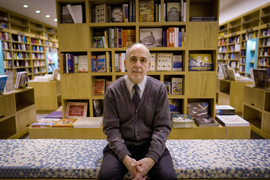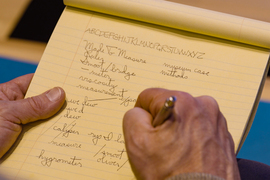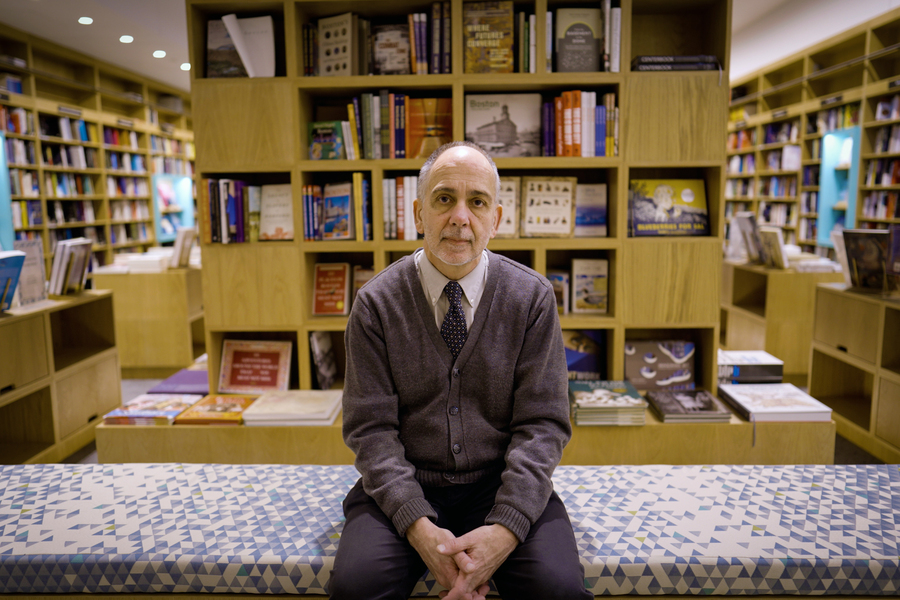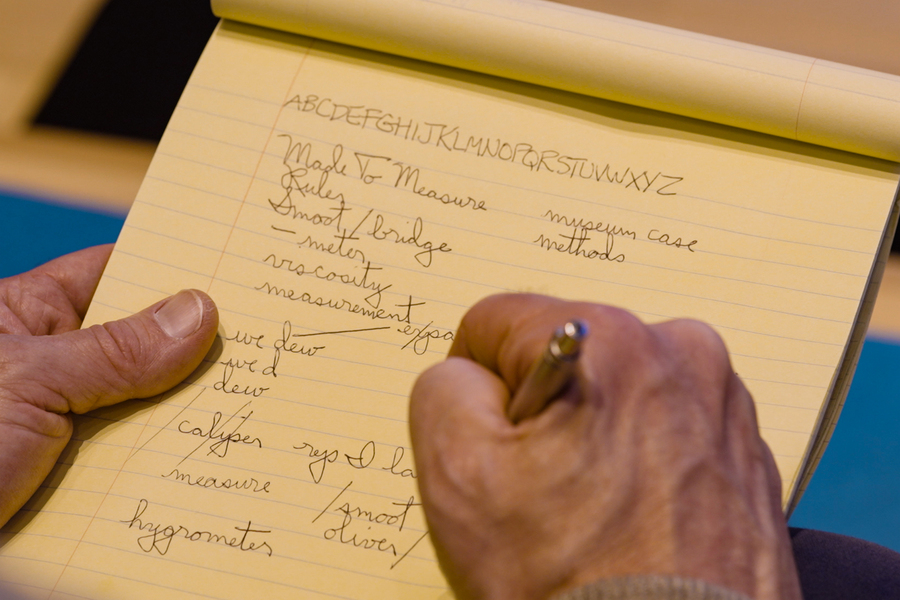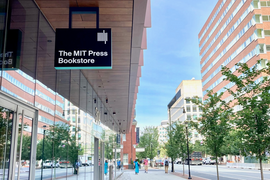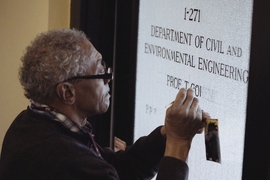Words have always played a central role in Barry Duncan’s life. He’s worked in bookstores for more than 40 years, reads often, and has tried his hand at writing novels, children’s books, song lyrics, and plays.
But it wasn’t until he stumbled onto the book “An Almanac of Words at Play” that Duncan realized words could go backwards. The discovery, which he made in the early 1980s, set him on a course he would follow for decades. For fun, and then out of habit, he began reversing words he saw in print, noticing words that took on new meaning when flipped, and writing sentences that could be read backward and forward — palindromes.
Today Duncan, who works as a staff member at the MIT Press Bookstore in Kendall Square, has developed a reputation as a professional palindromist. His creations have been featured in galleries, selected anthologies, and are the subject of an upcoming documentary. He’s written 800-word epics that don’t lose their meaning when flipped. He’s written reversible poems and tributes that were used as auction prizes. And he’s written countless palindromes to serve as gifts for birthdays, anniversaries, and other occasions.
Mostly, though, Duncan just writes palindromes for fun.
“I hope it gives people an idea of what can be accomplished in two directions,” he says. “Of course, I also hope that people will appreciate them. It’s always better if the person or organization for whom you’ve written a palindrome replies in a positive way. “
As palindromes have come to define him, Duncan hopes to move the ancient field into the mainstream and show people what’s possible.
“The thing I really want to do is establish palindrome writing as a literary form, to show people you can write palindromes that are beautiful and funny and factual and have real literary merit,” he says.
Writing in two directions
Duncan discovered a love for words while growing up in Cherry Hill, New Jersey. He began his first job at a bookstore in Philadelphia in 1979, and he’s continued to work in bookstores on and off ever since.
Before inventory was computerized, Duncan’s sharp memory for titles and authors served him well. Even as memorization became less of a necessity, Duncan grew to love the atmosphere.
“It’s always great to work in bookstores,” he says. “You work with clever, talented people, you meet wonderful customers,” he says. “When I left my first bookstore job in 1981 I thought, ‘I don’t need to do that again,’ and now I’ve done hardly anything but that.”
Something similar happened to Duncan when he discovered palindromes. He found the writing form interesting, but he didn’t think much else about it.
“I’d see a word and maybe reverse it, but it hadn’t occurred to me that you could tell a story or write about something that actually happened,” Duncan says. “Or you could read a headline and say, ‘I’ll write something about that.’ I just didn’t realize it could be done.”
Duncan’s passion for palindromes grew gradually. In 2008, he wrote a palindrome about the presidential election. Two years later, friends of his who owned the store Greenward in Cambridge’s Porter Square asked him to write a palindrome in honor of its third birthday. That palindrome ended up in “The Best American Nonrequired Reading of 2012.”
“I suddenly started to see things more clearly in two directions,” he says. “I started to write things that got better and better and more like normal writing, more like speech. I started to see I could do something a little more sophisticated than just putting together some kind of clumsy sentence.”
The work began to fulfill in him a lifelong passion for writing.
“Whereas before I tried my hand at novels and plays and songs, now this is the thing I do: I write in two directions,” he says.
Since hitting his stride, Duncan has taken to carrying a black pen and legal pad with him wherever he goes. To begin, he writes the letters of the alphabet on the top of the page. He’s had ideas on the train, at work, and on walks, but his preferred mode of writing is lying on his couch, his legal pad resting on his head and the letters swirling around in his mind.
“What I see is the middle of the palindrome first,” Duncan says. “You also have to think about vocabulary. You want something that sounds as much like normal language as possible, and your middle is important, but you don’t want it to be obvious that that’s where it turns, so you try to create a middle that’s seamless, if possible.”
Here’s a palindrome that Duncan wrote to commemorate the recent change of MIT presidents:
2.
Dual.
Is time. Rafael went, so passes.
Sally’ll assess a post. New leaf.
Are MIT’s.
I laud 2.
“I always tell people if you want to start writing palindromes you should start by reversing every word you say, every word you hear, every word you see, every word you write, then you start to internalize that,” Duncan says.
Duncan calls anything more than 100 characters a long palindrome. Anything more than 100 words is an epic palindrome. Then there’s the mega palindrome, something Duncan says he’s only done twice — once with the palindrome about his friend’s store (1,291 characters) and the 800-worder, which served as a dual biography of two colleagues from Harvard University Press bookstore.
“I like to say that anything anyone can write about in one direction I can write about in two directions,” he says.
At home at MIT
When Duncan came to MIT — a campus known for its quirky culture — he says he found a home.
“I think MIT was a very good place to land,” he says. “I’m in a fine reversible rhythm, I seem to find a lot to write about, and people seem to appreciate what I do. I love my job and feel like I’m in a very good place.”
Since coming to the Institute, Duncan has written palindromes for MIT.nano, the MIT Press, the MIT List Visual Arts Center, Tim the Beaver, and the Art, Culture, and Technology program. He’s currently writing a series of palindromes about the MIT Museum.
“People don’t see many good palindromes, so it’s a difficult thing to get people interested in,” Duncan says. “I’ll write something and send it to the people I think might appreciate it. I get great joy in writing them. I’ve done things with reversibility that I hope show it to be a little more versatile than you’d think.”
Some of Duncan’s palindromes have moved people to tears, a reaction he says he’s humbled by.
“I like that because I’ve always said if I’m reporting facts in a palindrome I want those facts to be accurate and if I’m expressing emotion I want that emotion to be genuine,” he says.
As he advances the craft, Duncan hopes palindromes become a more well-known form of writing — and maybe more.
“I’d like people to know that new literary things can be done,” Duncan says. “And I think something can be done with reversibility beyond writing palindromes, but I don’t know what exactly. If you could ever solve a problem just with reversible patterns that would be great. But if this is all it is, just writing palindromes, that’s still pretty satisfying to me.”
